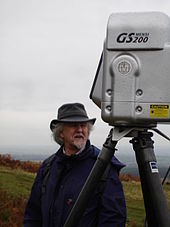- Martin Brasier
-
Martin David Brasier 
Born 12 April 1947
Wimbledon, London, EnglandNationality United Kingdom Fields Palaeontology Evolutionary Biology Micropaleontology Institutions University of Hull
University of OxfordAlma mater University of London Doctoral students Duncan McIlroy, Nicola McCloughlin, Jonathan Antcliffe, Richard Callow Martin David Brasier FLS (born 12 April 1947) is an English paleontologist made known from his study of microfossils, the Origin of Life, and Precambrian fossils such as the Ediacara biota. He is Professor of Palaeobiology at the University of Oxford.[1] He has worked on the Cambrian Explosion and was leader of UN's IGCP project on defining the Cambrian geological period.[2] His own book on the subject, Darwin's Lost World: The hidden history of animal life was published in 2009 as part of the Charles Darwin centenary celebrations.[3]
Contents
Biography
Work
His research concerns the evolution of the earliest biosphere from the origins of life to the emergence of animals during the Cambrian explosion. He has placed emphasis upon the importance of high resolution contextural analysis (mapping at all scales, especially microscopy). Early research from 1969 onwards involved mapping the microhabitat of Foraminifera living in association with protistan endosymbionts, plus cyanobacteria, microbial mats, algae, seagrass and mangroves in the Caribbean. This led to a geometrical exploration of foraminiferid skeletal morphospace and its potential for mapping the evolution of photosymbioses and seagrass communities through time.
By 1975 he was attempting a data-based ecological and taphonomic assessment of the Cambrian explosion of skeletal fossils, some of the earliest such quantitative work done on the Cambrian Explosion. During 1978 he co-organised the first international symposium on the Cambrian explosion, for the Systematics Association resulting in the first collected volume of essays related to this subject. In 1980, he ran the first international symposium of the British Micropalaeontological Society (now The Micropalaeontological Society).
During the 1980s and early 1990s he used new technologies such as isotope analysis to bring high resolution contextual analysis to the Ediacaran and Cambrian evolutionary radiations and the origins of the major invertebrate groups. He was secretary and then leader of the International Geoscience Programme, UNESCO and International Commission on Stratigraphy Projects on the Precambrian-Cambrian Boundary decision. This defined the base of Cambrian Period at a section in Newfoundland based on the appearance of the first assemblage of vertical burrowing animal trace fossils Treptichnus pedum.
He has since sought to push back the boundaries of integrated, high resolution mapping from the Snowball Earth c. 720 Ma ago to the very first examples of possible fossils in the geological record at c. 3500 Ma. He has recently pioneered the application of several high resolution techniques to palaeontology, ranging from satellite imaging and field mapping to microscopic mapping using Confocal Microscopy, Raman spectroscopy, NanoSims Microprobes, and using lasers for high resolution 3D scanning. These have played a particular role in his recent work on the Precambrian, notably in the debates surrounding the Apex Chert and the Ediacara biota
Appointments and accomplishments
Date Position 1966–1969 Chelsea College University of London: First Class Honours in Geology (B.Sc.) 1969–1972 UCL University of London: "Distribution and ecology of recent Foraminifera from the lagoons and surrounding waters of Barbuda, West Indies." PhD 1970 HMS Fawn and HMS Fox (Hydrographic Department, Royal Navy), Ships’ Scientist 1972–1973 Micropalaeontologist, Palaeontology Department, Institute of Geological Sciences (now British Geological Survey) 1973–1974 Lecturer, Geology Department, University of Reading 1974–1986 Lecturer, Geology Department, University of Hull 1986–1990 Reader in Palaeobiology, University of Hull 1988 - Tutorial Fellow, St Edmund Hall, University of Oxford 1988–1996 Lecturer in Geology, Department of Earth Sciences, University of Oxford 1990–1994 Presiding Chairman and elector for the Precambrian-Cambrian boundary decision, and leader of IGCP Project 303. 1996–2004 Appointed Reader in Earth Sciences, University of Oxford 2004- Professor of Palaeobiology, University of Oxford 2007- Adjunct Professor, Memorial University of Newfoundland Bibliography
Books
- Brasier, M.D. 2009. Darwin's Lost World: the hidden history of animal life. Oxford University Press,. 322pp.
- Armstrong, H.A. & Brasier, M.D. 2004. 'Microfossils'. Second Edition. Blackwells, Oxford
- Cowie, J.W. and Brasier, M.D. (Eds.) 1989 'The Precambrian-Cambrian Boundary', Oxford Monographs in Geology and Geophysics, No. 12.
- Neale, JW. & Brasier, M.D. (Eds). 1981.'Microfossils from Recent and Fossil Shelf Seas'. British Micropalaeontological Society. Ellis Horwood/Wiley, Chichester, 380pp.
- Brasier, MD. 1980. 'Microfossils'. George Allen & Unwin, London, 193pp. Reprinted 1981, 1983 (Unwin), 1988 (Unwin Hyman), 1992, 1994 (Chapman & Hall). Translated into Chinese and Japanese.
References
- ^ "Oxford University staff". http://www.earth.ox.ac.uk/people/profiles/academic/martinb. Retrieved 2011-03-02.
- ^ "Episodes article Precambrian-Cambrian IGCP". http://www.episodes.co.in/www/backissues/171/Articles--3.pdf. Retrieved 2011-03-02.
- ^ Martin Brasier. "Darwin's Lost World at Oxford University Press". http://ukcatalogue.oup.com/product/9780199548972.do. Retrieved 2011-03-02.
External links
Categories:- 1947 births
- Living people
- Alumni of the University of London
- Academics of the University of Oxford
- British paleontologists
Wikimedia Foundation. 2010.


